Nicholas P. Cheremisinoff. Handbook of Solid Waste Management and Waste Minimization Technologies
Подождите немного. Документ загружается.

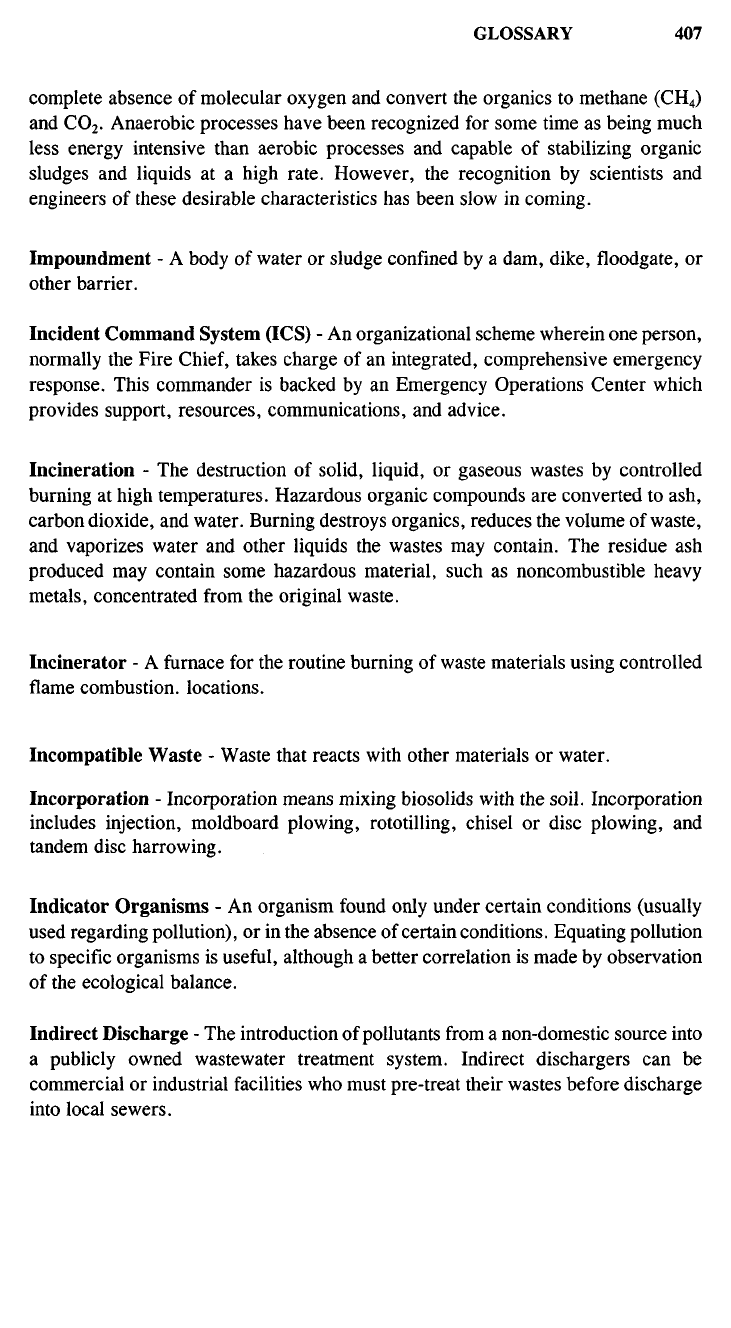
complete absence of molecular oxygen and convert the organics to methane (CH
4
)
and CO
2
. Anaerobic processes have been recognized for some time as being much
less energy intensive than aerobic processes and capable of stabilizing organic
sludges and liquids at a high rate. However, the recognition by scientists and
engineers of these desirable characteristics has been slow in coming.
Impoundment - A body of water or sludge confined by a dam, dike, floodgate, or
other barrier.
Incident Command System (ICS) - An organizational scheme wherein one person,
normally the Fire
Chief,
takes charge of an integrated, comprehensive emergency
response. This commander is backed by an Emergency Operations Center which
provides support, resources, communications, and advice.
Incineration - The destruction of solid, liquid, or gaseous wastes by controlled
burning at high temperatures. Hazardous organic compounds are converted to ash,
carbon dioxide, and water. Burning destroys organics, reduces the volume of waste,
and vaporizes water and other liquids the wastes may contain. The residue ash
produced may contain some hazardous material, such as noncombustible heavy
metals, concentrated from the original waste.
Incinerator - A furnace for the routine burning of waste materials using controlled
flame combustion, locations.
Incompatible Waste - Waste that reacts with other materials or water.
Incorporation - Incorporation means mixing biosolids with the soil. Incorporation
includes injection, moldboard plowing, rototilling, chisel or disc plowing, and
tandem disc harrowing.
Indicator Organisms - An organism found only under certain conditions (usually
used regarding pollution), or in the absence of certain conditions. Equating pollution
to specific organisms is useful, although a better correlation is made by observation
of the ecological balance.
Indirect Discharge - The introduction of pollutants from a non-domestic source into
a publicly owned waste water treatment system. Indirect dischargers can be
commercial or industrial facilities who must pre-treat their wastes before discharge
into local sewers.
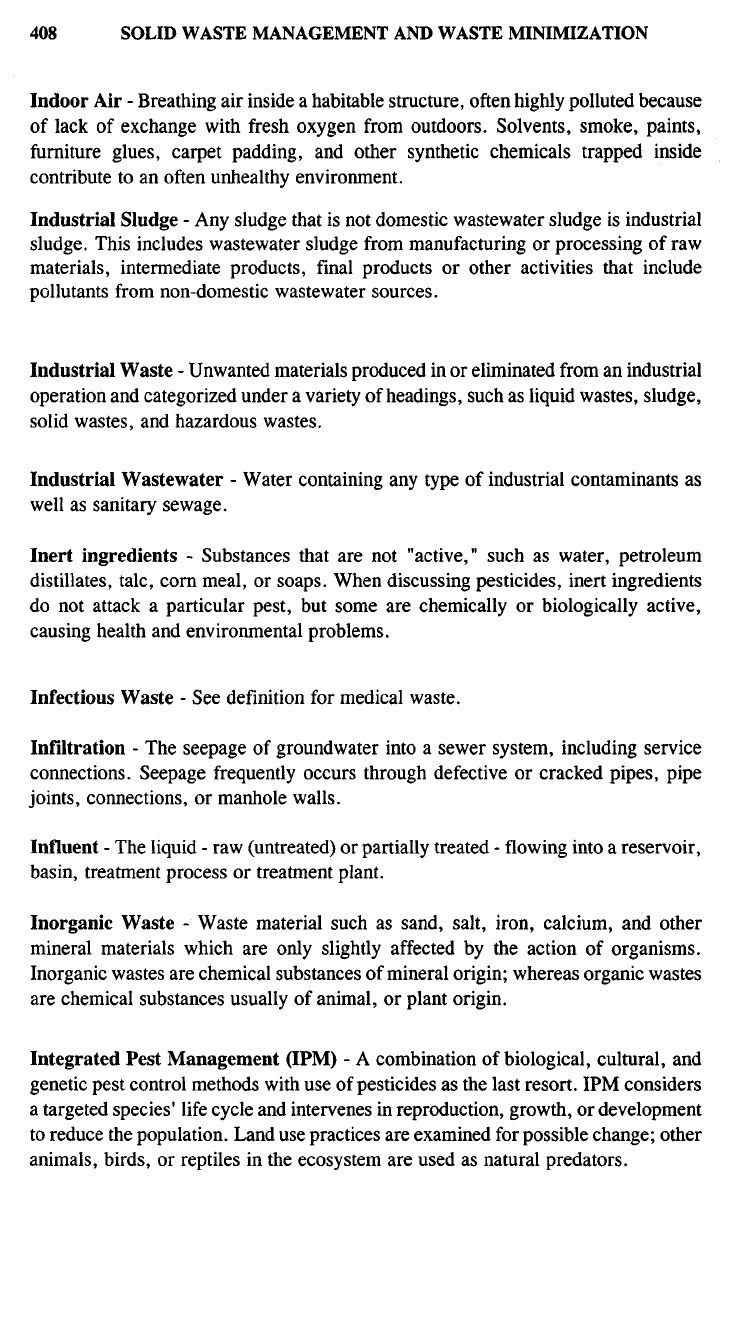
Indoor Air - Breathing air inside a habitable structure, often highly polluted because
of lack of exchange with fresh oxygen from outdoors. Solvents, smoke, paints,
furniture glues, carpet padding, and other synthetic chemicals trapped inside
contribute to an often unhealthy environment.
Industrial Sludge - Any sludge that is not domestic wastewater sludge is industrial
sludge. This includes wastewater sludge from manufacturing or processing of raw
materials, intermediate products, final products or other activities that include
pollutants from non-domestic wastewater sources.
Industrial Waste - Unwanted materials produced in or eliminated from an industrial
operation and categorized under a variety of headings, such as liquid wastes, sludge,
solid wastes, and hazardous wastes.
Industrial Wastewater - Water containing any type of industrial contaminants as
well as sanitary sewage.
Inert ingredients - Substances that are not "active," such as water, petroleum
distillates, talc, corn meal, or soaps. When discussing pesticides, inert ingredients
do not attack a particular pest, but some are chemically or biologically active,
causing health and environmental problems.
Infectious Waste - See definition for medical waste.
Infiltration - The seepage of groundwater into a sewer system, including service
connections. Seepage frequently occurs through defective or cracked pipes, pipe
joints,
connections, or manhole walls.
Influent - The liquid - raw (untreated) or partially treated - flowing into a reservoir,
basin, treatment process or treatment plant.
Inorganic Waste - Waste material such as sand, salt, iron, calcium, and other
mineral materials which are only slightly affected by the action of organisms.
Inorganic wastes are chemical substances of mineral origin; whereas organic wastes
are chemical substances usually of animal, or plant origin.
Integrated Pest Management (IPM) - A combination of biological, cultural, and
genetic pest control methods with use of pesticides as the last resort. IPM considers
a targeted species' life cycle and intervenes in reproduction, growth, or development
to reduce the population. Land use practices are examined for possible change; other
animals, birds, or reptiles in the ecosystem are used as natural predators.
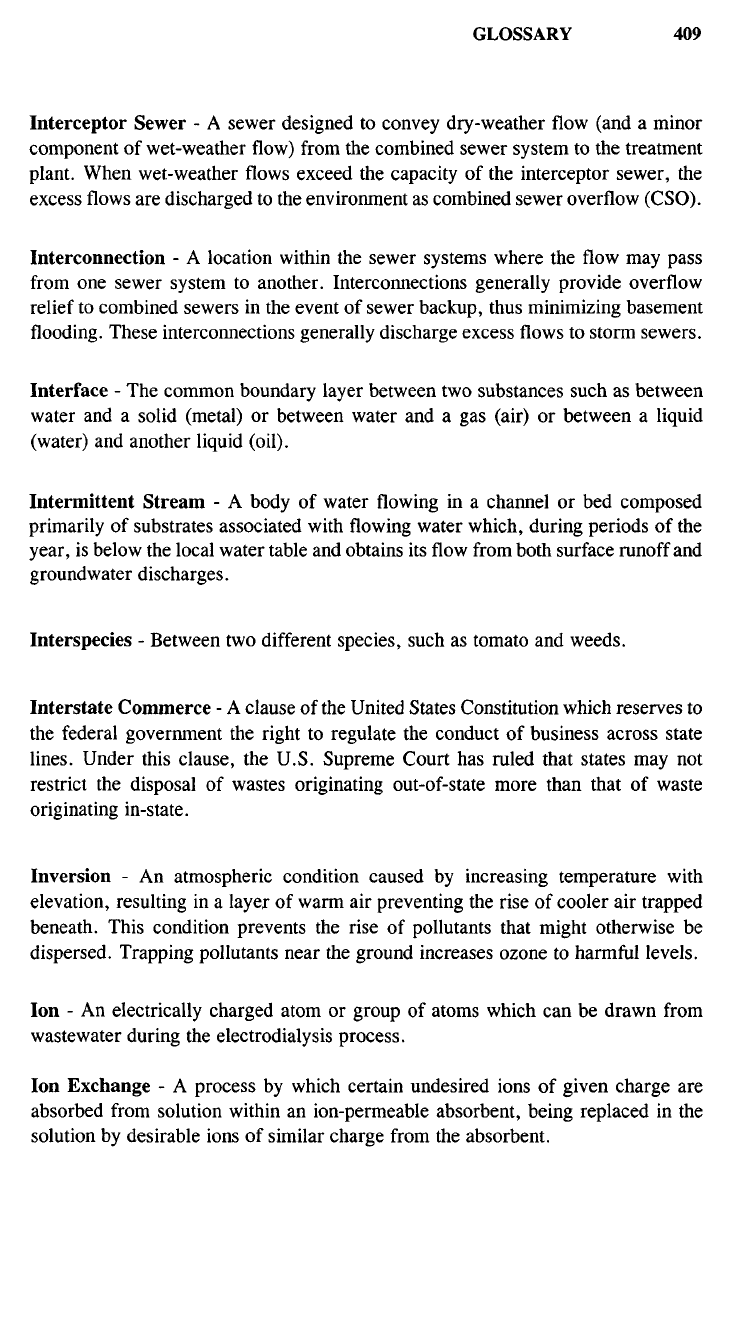
Interceptor Sewer - A sewer designed to convey dry-weather flow (and a minor
component of wet-weather flow) from the combined sewer system to the treatment
plant. When wet-weather flows exceed the capacity of the interceptor sewer, the
excess flows are discharged to the environment as combined sewer overflow (CSO).
Interconnection - A location within the sewer systems where the flow may pass
from one sewer system to another. Interconnections generally provide overflow
relief to combined sewers in the event of sewer backup, thus minimizing basement
flooding. These interconnections generally discharge excess flows to storm sewers.
Interface - The common boundary layer between two substances such as between
water and a solid (metal) or between water and a gas (air) or between a liquid
(water) and another liquid (oil).
Intermittent Stream - A body of water flowing in a channel or bed composed
primarily of substrates associated with flowing water which, during periods of the
year, is below the local water table and obtains its flow from both surface runoff and
groundwater discharges.
Interspecies - Between two different species, such as tomato and weeds.
Interstate Commerce - A clause of the United States Constitution which reserves to
the federal government the right to regulate the conduct of business across state
lines.
Under this clause, the U.S. Supreme Court has ruled that states may not
restrict the disposal of wastes originating out-of-state more than that of waste
originating in-state.
Inversion - An atmospheric condition caused by increasing temperature with
elevation, resulting in a layer of warm air preventing the rise of cooler air trapped
beneath. This condition prevents the rise of pollutants that might otherwise be
dispersed. Trapping pollutants near the ground increases ozone to harmful levels.
Ion - An electrically charged atom or group of atoms which can be drawn from
wastewater during the electrodialysis process.
Ion Exchange - A process by which certain undesired ions of given charge are
absorbed from solution within an ion-permeable absorbent, being replaced in the
solution by desirable ions of similar charge from the absorbent.
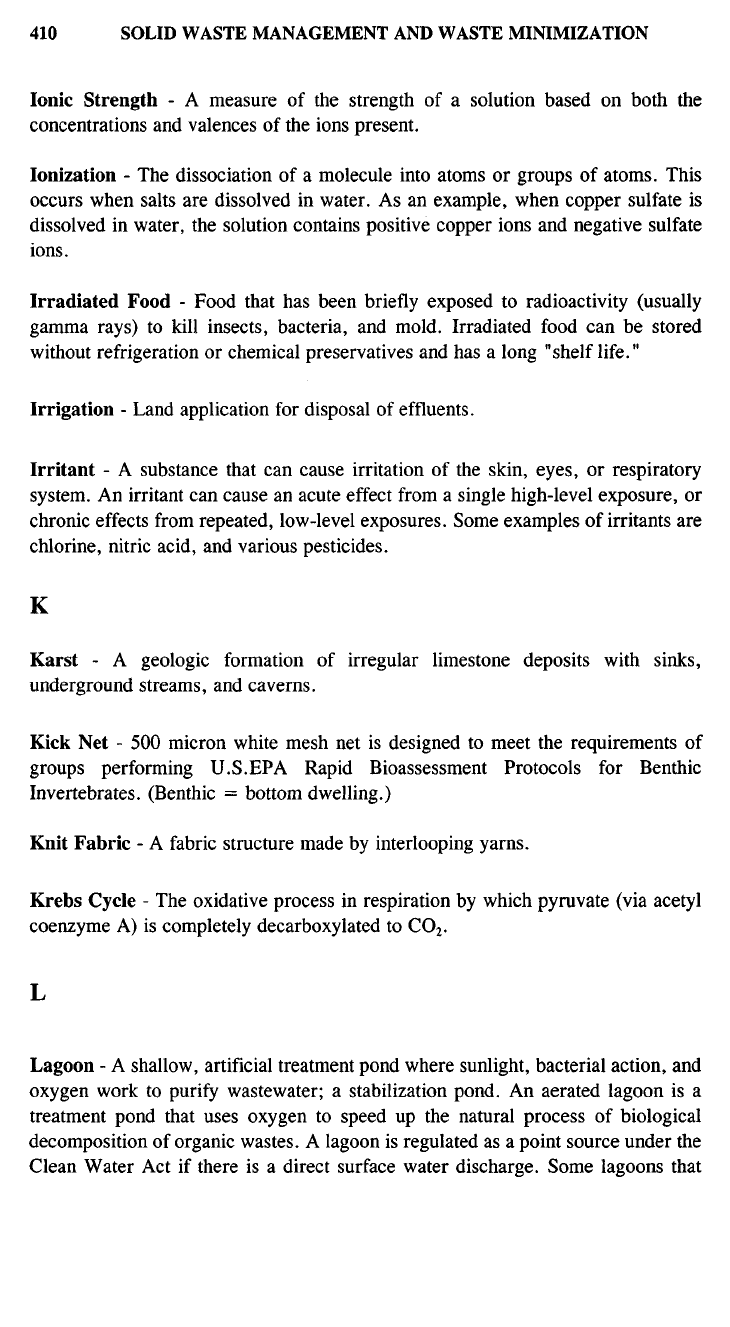
Ionic Strength - A measure of the strength of a solution based on both the
concentrations and valences of the ions present.
Ionization - The dissociation of a molecule into atoms or groups of atoms. This
occurs when salts are dissolved in water. As an example, when copper sulfate is
dissolved in water, the solution contains positive copper ions and negative sulfate
ions.
Irradiated Food - Food that has been briefly exposed to radioactivity (usually
gamma rays) to kill insects, bacteria, and mold. Irradiated food can be stored
without refrigeration or chemical preservatives and has a long "shelf life."
Irrigation - Land application for disposal of effluents.
Irritant - A substance that can cause irritation of the skin, eyes, or respiratory
system. An irritant can cause an acute effect from a single high-level exposure, or
chronic effects from repeated, low-level exposures. Some examples of irritants are
chlorine, nitric acid, and various pesticides.
K
Karst - A geologic formation of irregular limestone deposits with sinks,
underground streams, and caverns.
Kick Net - 500 micron white mesh net is designed to meet the requirements of
groups performing U.S.EPA Rapid Bioassessment Protocols for Benthic
Invertebrates. (Benthic = bottom dwelling.)
Knit Fabric - A fabric structure made by interlooping yarns.
Krebs Cycle - The oxidative process in respiration by which pyruvate (via acetyl
coenzyme A) is completely decarboxylated to CO
2
.
L
Lagoon - A shallow, artificial treatment pond where sunlight, bacterial action, and
oxygen work to purify wastewater; a stabilization pond. An aerated lagoon is a
treatment pond that uses oxygen to speed up the natural process of biological
decomposition of organic wastes. A lagoon is regulated as a point source under the
Clean Water Act if there is a direct surface water discharge. Some lagoons that
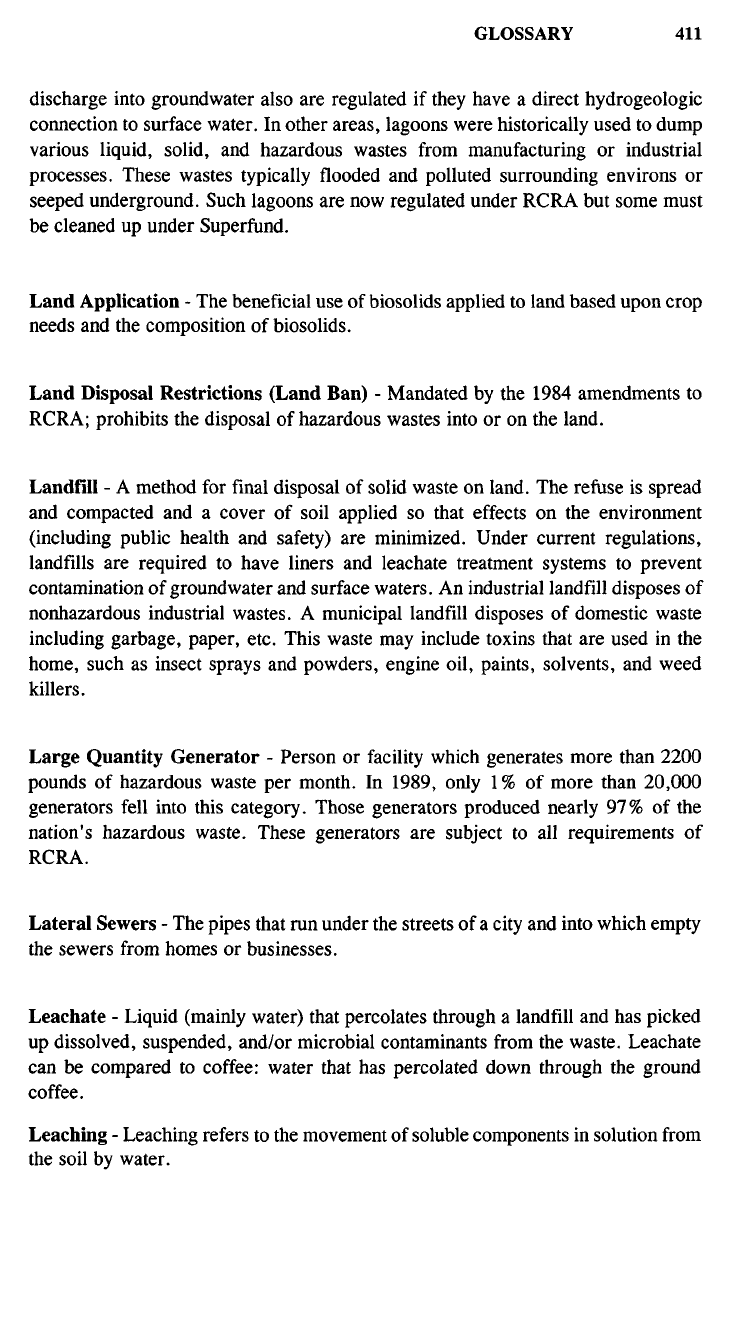
discharge into groundwater also are regulated if they have a direct hydrogeologic
connection to surface water. In other areas, lagoons were historically used to dump
various liquid, solid, and hazardous wastes from manufacturing or industrial
processes. These wastes typically flooded and polluted surrounding environs or
seeped underground. Such lagoons are now regulated under RCRA but some must
be cleaned up under Superfund.
Land Application - The beneficial use of biosolids applied to land based upon crop
needs and the composition of biosolids.
Land Disposal Restrictions (Land Ban) - Mandated by the 1984 amendments to
RCRA; prohibits the disposal of hazardous wastes into or on the land.
Landfill - A method for final disposal of solid waste on land. The refuse is spread
and compacted and a cover of soil applied so that effects on the environment
(including public health and safety) are minimized. Under current regulations,
landfills are required to have liners and leachate treatment systems to prevent
contamination of groundwater and surface waters. An industrial landfill disposes of
nonhazardous industrial wastes. A municipal landfill disposes of domestic waste
including garbage, paper, etc. This waste may include toxins that are used in the
home, such as insect sprays and powders, engine oil, paints, solvents, and weed
killers.
Large Quantity Generator - Person or facility which generates more than 2200
pounds of hazardous waste per month. In 1989, only 1% of more than 20,000
generators fell into this category. Those generators produced nearly 97% of the
nation's hazardous waste. These generators are subject to all requirements of
RCRA.
Lateral Sewers - The pipes that run under the streets of a city and into which empty
the sewers from homes or businesses.
Leachate - Liquid (mainly water) that percolates through a landfill and has picked
up dissolved, suspended, and/or microbial contaminants from the waste. Leachate
can be compared to coffee: water that has percolated down through the ground
coffee.
Leaching - Leaching refers to the movement of soluble components in solution from
the soil by water.
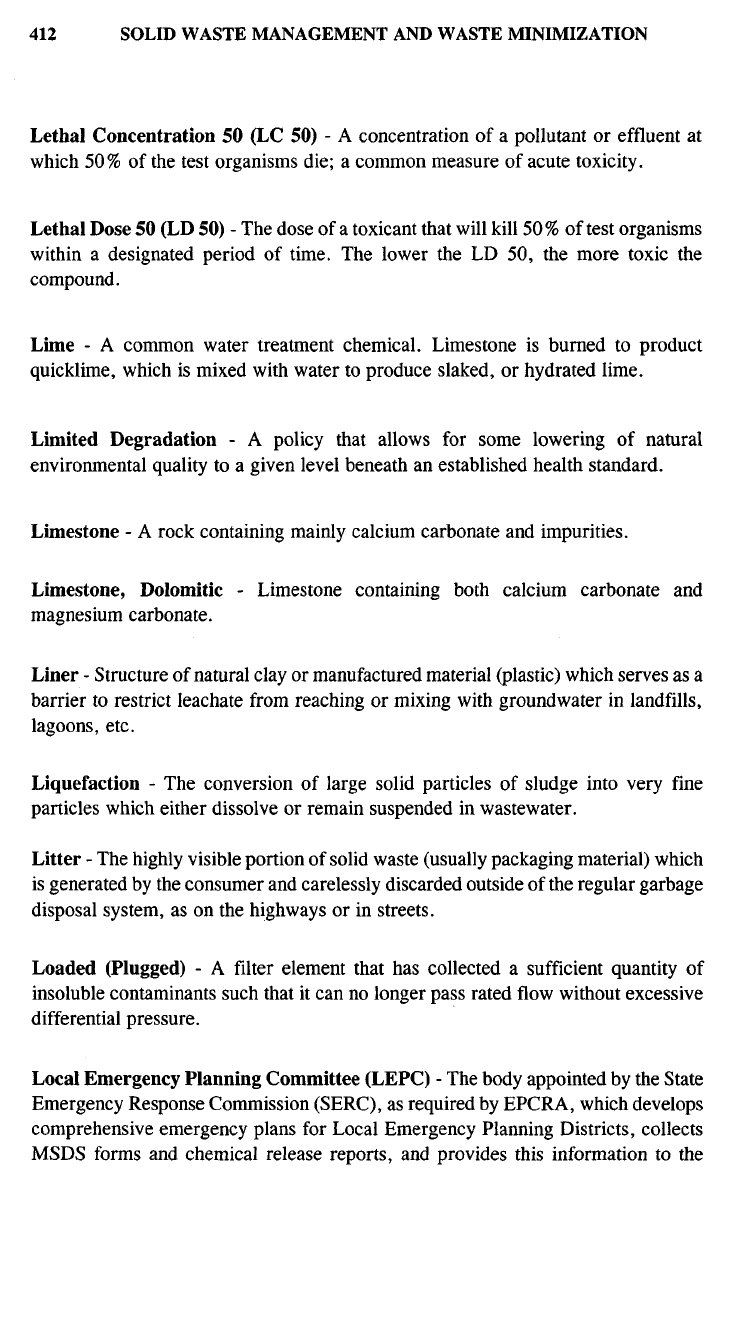
Lethal Concentration 50 (LC 50) - A concentration of a pollutant or effluent at
which 50% of the test organisms die; a common measure of acute toxicity.
Lethal Dose 50 (LD 50) - The dose of a toxicant that will kill 50% of test organisms
within a designated period of time. The lower the LD 50, the more toxic the
compound.
Lime - A common water treatment chemical. Limestone is burned to product
quicklime, which is mixed with water to produce slaked, or hydrated lime.
Limited Degradation - A policy that allows for some lowering of natural
environmental quality to a given level beneath an established health standard.
Limestone - A rock containing mainly calcium carbonate and impurities.
Limestone, Dolomitic - Limestone containing both calcium carbonate and
magnesium carbonate.
Liner - Structure of natural clay or manufactured material (plastic) which serves as a
barrier to restrict leachate from reaching or mixing with ground water in landfills,
lagoons, etc.
Liquefaction - The conversion of large solid particles of sludge into very fine
particles which either dissolve or remain suspended in wastewater.
Litter - The highly visible portion of solid waste (usually packaging material) which
is generated by the consumer and carelessly discarded outside of the regular garbage
disposal system, as on the highways or in streets.
Loaded (Plugged) - A filter element that has collected a sufficient quantity of
insoluble contaminants such that it can no longer pass rated flow without excessive
differential pressure.
Local Emergency Planning Committee (LEPC) - The body appointed by the State
Emergency Response Commission (SERC), as required by EPCRA, which develops
comprehensive emergency plans for Local Emergency Planning Districts, collects
MSDS forms and chemical release reports, and provides this information to the
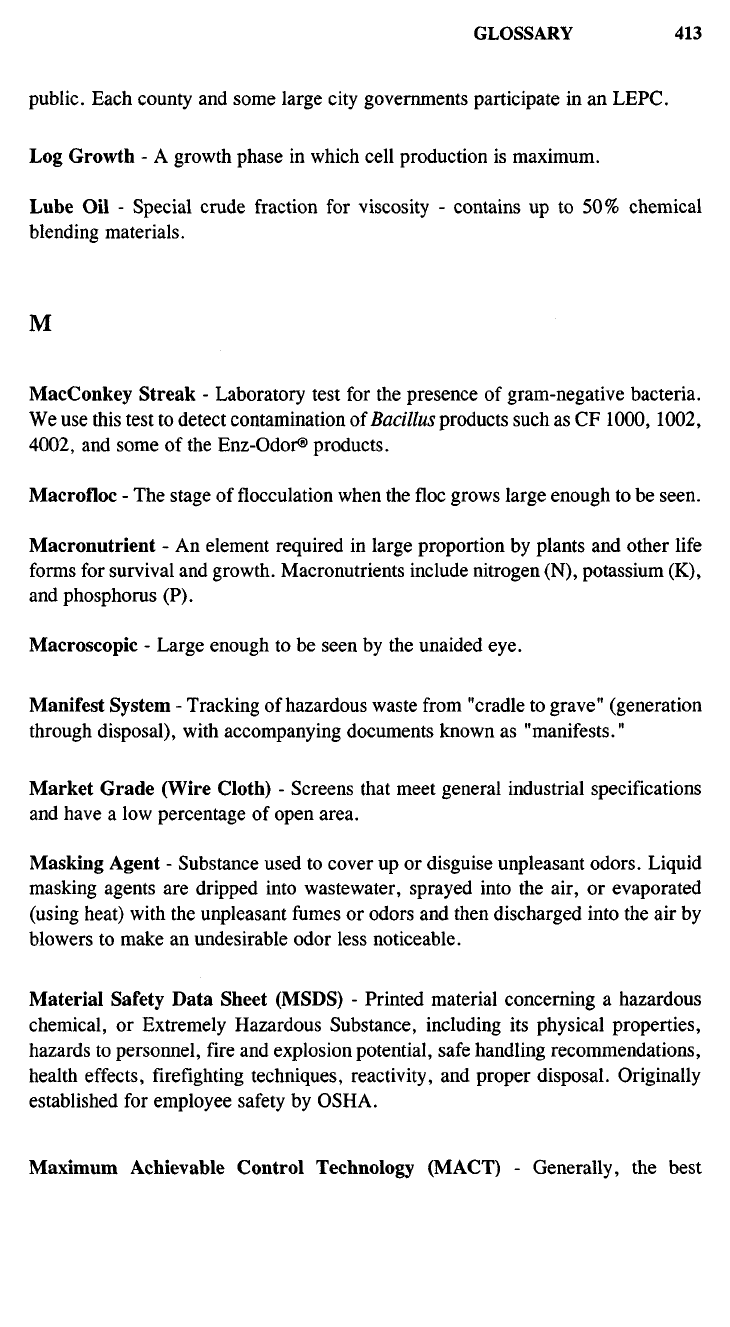
public. Each county and some large city governments participate in an LEPC.
Log Growth - A growth phase in which cell production is maximum.
Lube Oil - Special crude fraction for viscosity - contains up to 50% chemical
blending materials.
M
MacConkey Streak - Laboratory test for the presence of gram-negative bacteria.
We use this test to detect contamination of Bacillus products such as CF 1000,1002,
4002,
and some of the Enz-Odor® products.
Macrofloc - The stage of flocculation when the floe grows large enough to be seen.
Macronutrient - An element required in large proportion by plants and other life
forms for survival and growth. Macronutrients include nitrogen (N), potassium (K),
and phosphorus (P).
Macroscopic - Large enough to be seen by the unaided eye.
Manifest System - Tracking of hazardous waste from "cradle to grave" (generation
through disposal), with accompanying documents known as "manifests."
Market Grade (Wire Cloth) - Screens that meet general industrial specifications
and have a low percentage of open area.
Masking Agent - Substance used to cover up or disguise unpleasant odors. Liquid
masking agents are dripped into wastewater, sprayed into the air, or evaporated
(using heat) with the unpleasant fumes or odors and then discharged into the air by
blowers to make an undesirable odor less noticeable.
Material Safety Data Sheet (MSDS) - Printed material concerning a hazardous
chemical, or Extremely Hazardous Substance, including its physical properties,
hazards to personnel, fire and explosion potential, safe handling recommendations,
health effects, firefighting techniques, reactivity, and proper disposal. Originally
established for employee safety by OSHA.
Maximum Achievable Control Technology (MACT) - Generally, the best
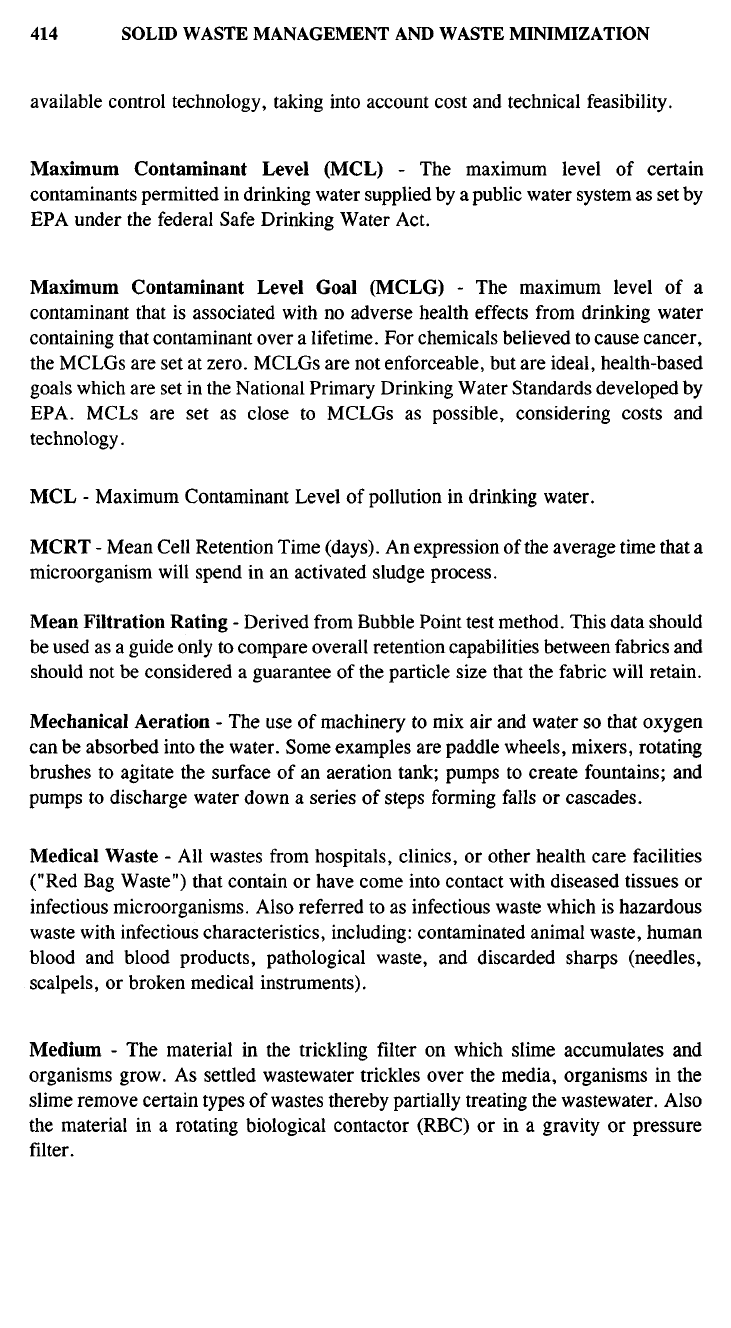
available control technology, taking into account cost and technical feasibility.
Maximum Contaminant Level (MCL) - The maximum level of certain
contaminants permitted in drinking water supplied by a public water system as set by
EPA under the federal Safe Drinking Water Act.
Maximum Contaminant Level Goal (MCLG) - The maximum level of a
contaminant that is associated with no adverse health effects from drinking water
containing that contaminant over a lifetime. For chemicals believed to cause cancer,
the MCLGs are set at zero. MCLGs are not enforceable, but are ideal, health-based
goals which are set in the National Primary Drinking Water Standards developed by
EPA. MCLs are set as close to MCLGs as possible, considering costs and
technology.
MCL - Maximum Contaminant Level of pollution in drinking water.
MCRT - Mean Cell Retention Time (days). An expression of the average time that a
microorganism will spend in an activated sludge process.
Mean Filtration Rating - Derived from Bubble Point test method. This data should
be used as a guide only to compare overall retention capabilities between fabrics and
should not be considered a guarantee of the particle size that the fabric will retain.
Mechanical Aeration - The use of machinery to mix air and water so that oxygen
can be absorbed into the water. Some examples are paddle wheels, mixers, rotating
brushes to agitate the surface of an aeration tank; pumps to create fountains; and
pumps to discharge water down a series of steps forming falls or cascades.
Medical Waste - All wastes from hospitals, clinics, or other health care facilities
("Red Bag Waste") that contain or have come into contact with diseased tissues or
infectious microorganisms. Also referred to as infectious waste which is hazardous
waste with infectious characteristics, including: contaminated animal waste, human
blood and blood products, pathological waste, and discarded sharps (needles,
scalpels, or broken medical instruments).
Medium - The material in the trickling filter on which slime accumulates and
organisms grow. As settled wastewater trickles over the media, organisms in the
slime remove certain types of wastes thereby partially treating the wastewater. Also
the material in a rotating biological contactor (RBC) or in a gravity or pressure
filter.
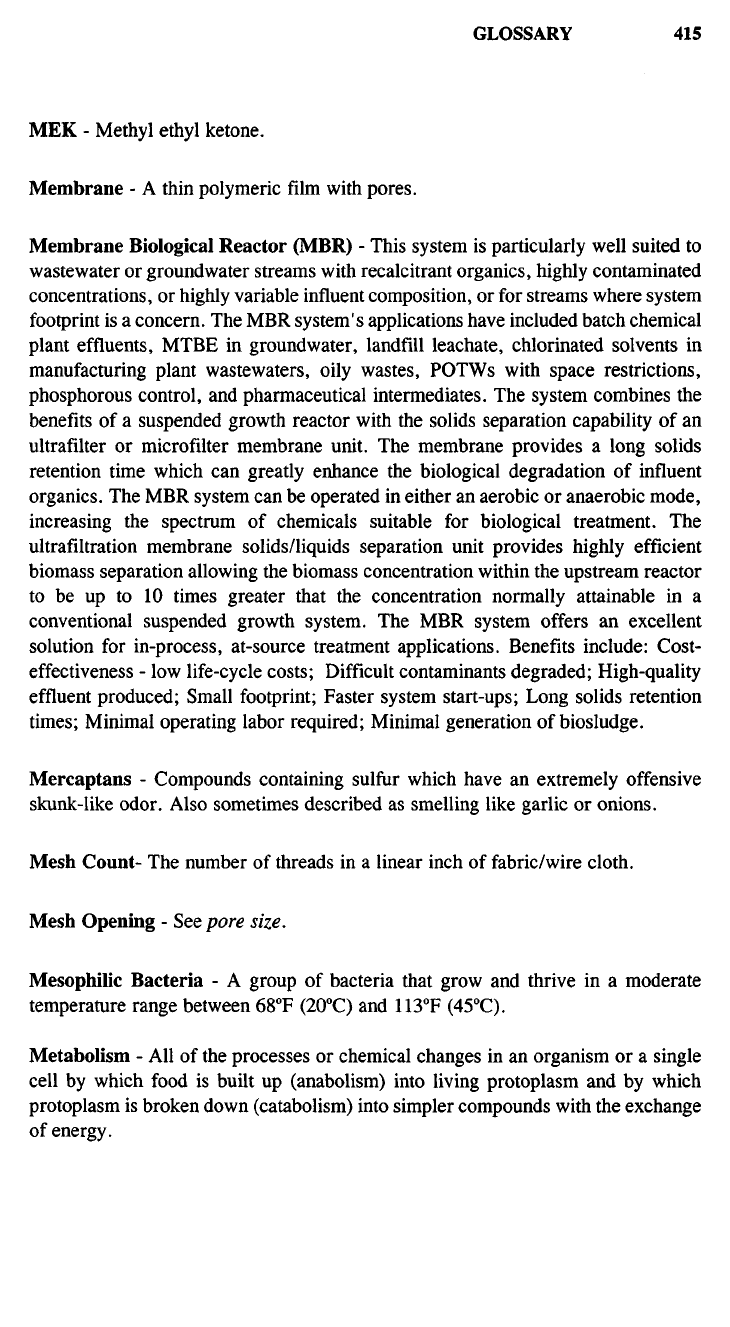
MEK - Methyl ethyl ketone.
Membrane - A thin polymeric film with pores.
Membrane Biological Reactor (MBR) - This system is particularly well suited to
waste water or groundwater streams with recalcitrant organics, highly contaminated
concentrations, or highly variable influent composition, or for streams where system
footprint is a concern. The MBR system's applications have included batch chemical
plant effluents, MTBE in groundwater, landfill leachate, chlorinated solvents in
manufacturing plant waste
waters,
oily wastes, POTWs with space restrictions,
phosphorous control, and pharmaceutical intermediates. The system combines the
benefits of a suspended growth reactor with the solids separation capability of an
ultrafilter or microfilter membrane unit. The membrane provides a long solids
retention time which can greatly enhance the biological degradation of influent
organics. The MBR system can be operated in either an aerobic or anaerobic mode,
increasing the spectrum of chemicals suitable for biological treatment. The
ultrafiltration membrane solids/liquids separation unit provides highly efficient
biomass separation allowing the biomass concentration within the upstream reactor
to be up to 10 times greater that the concentration normally attainable in a
conventional suspended growth system. The MBR system offers an excellent
solution for in-process, at-source treatment applications. Benefits include: Cost-
effectiveness - low life-cycle costs; Difficult contaminants degraded; High-quality
effluent produced; Small footprint; Faster system start-ups; Long solids retention
times;
Minimal operating labor required; Minimal generation of biosludge.
Mercaptans - Compounds containing sulfur which have an extremely offensive
skunk-like odor. Also sometimes described as smelling like garlic or onions.
Mesh Count- The number of threads in a linear inch of fabric/wire cloth.
Mesh Opening - See pore size.
Mesophilic Bacteria - A group of bacteria that grow and thrive in a moderate
temperature range between 68
0
F (2O
0
C) and 113
0
F (45
0
C).
Metabolism - All of the processes or chemical changes in an organism or a single
cell by which food is built up (anabolism) into living protoplasm and by which
protoplasm is broken down (catabolism) into simpler compounds with the exchange
of energy.

Metalized Screens - Screens that have been metalized with nickel. These screens
will bleed off static charges, promote EMC and reflect electromagnetic energy.
Metals - Limitations have been placed on the quantities of metals that can be
discharged from treating plants. Specification are not always consistent nor are they
the same for every operation. A processor must analyze his process for compliance.
List of metals with restrictions: aluminum; cadmium; manganese; arsenic; nickel;
ammonia copper nitrates; antimony cyanide phosphorus; barium chlorides;
selenium; beryllium fluoride; silver; bromide; iron sulfide; bromates; lead; zinc;
boron; mercury.
mg/1 - Milligrams per liter = ppm (parts per million). Expresses a measure of the
concentration by weight of a substance per unit volume.
MGD - Million gallons daily - refers to the flow through a waste treatment plant.
Microbes - Minute plant or animal life. Some microbes which may cause disease
exist in sewage.
Microorganisms - Bacteria, yeasts, simple fungi, algae, protozoans, and a number
of other organisms that are microscopic in size. Most are beneficial but some
produce disease. Others are involved in composting and sewage treatment.
Micron - A unit of length. One millionth of a meter or one thousandth of a
millimeter. One micron equals 0.00004 of an inch.
Micronutrient - An element required by plants and bacteria, in proportionately
smaller amounts, for survival and growth. Micronutrients include: iron (Fe),
manganese (MN), zinc (Zn), boron (B), and molybdenum (Mo).
Microorganisms - small organisms which require a microscope to be seen.
MIK - Methyl isobutyl ketone.
Mill Grade (Wire Cloth) - Stainless steel screens that have moderate open area and
good strength.
Milligrams/liter (mg/1) - A measure of concentration used in the measurement of
fluids. Mg/1 is the most common way to present a concentration in water and is
roughly equivalent to parts per million.
Next Page
